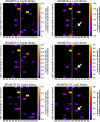Identification of Protease Specificity by Combining Proteome-Derived Peptide Libraries and Quantitative Proteomics
- PMID: 27122596
- PMCID: PMC4937521
- DOI: 10.1074/mcp.O115.056671
Identification of Protease Specificity by Combining Proteome-Derived Peptide Libraries and Quantitative Proteomics
Abstract
We present protease specificity profiling based on quantitative proteomics in combination with proteome-derived peptide libraries. Peptide libraries are generated by endoproteolytic digestion of proteomes without chemical modification of primary amines before exposure to a protease under investigation. After incubation with a test protease, treated and control libraries are differentially isotope-labeled using cost-effective reductive dimethylation. Upon analysis by liquid chromatography-tandem mass spectrometry, cleavage products of the test protease appear as semi-specific peptides that are enriched for the corresponding isotope label. We validate our workflow with two proteases with well-characterized specificity profiles: trypsin and caspase-3. We provide the first specificity profile of a protease encoded by a human endogenous retrovirus and for chlamydial protease-like activity factor (CPAF). For CPAF, we also highlight the structural basis of negative subsite cooperativity between subsites S1 and S2'. For A disintegrin and metalloproteinase with thrombospondin motifs (ADAMTS) -4, -5, and -15, we show a canonical preference profile, including glutamate in P1 and glycine in P3'. In total, we report nearly 4000 cleavage sites for seven proteases. Our protocol is fast, avoids enrichment or synthesis steps, and enables probing for lysine selectivity as well as subsite cooperativity. Due to its simplicity, we anticipate usability by most proteomic laboratories.
© 2016 by The American Society for Biochemistry and Molecular Biology, Inc.
Figures




References
-
- Lai Z. W., Petrera A., and Schilling O. (2014) The emerging role of the peptidome in biomarker discovery and degradome profiling. Biol. Chem. 24, 71–79 - PubMed
-
- Petrera A., Lai Z. W., and Schilling O. (2014) Carboxyterminal protein processing in health and disease: Key actors and emerging technologies. J. Proteome Res. 13, 4497–4504 - PubMed
-
- Shahinian H., Tholen S., and Schilling O. (2013) Proteomic identification of protease cleavage sites: Cell-biological and biomedical applications. Expert Rev. Proteomics 10, 421–433 - PubMed
-
- Schechter I., and Berger A. (1968) On the active site of proteases. 3. Mapping the active site of papain; specific peptide inhibitors of papain. Biochem. Biophys. Res. Commun. 32, 898–902 - PubMed
-
- Schilling O., and Overall C. M. (2008) Proteome-derived, database-searchable peptide libraries for identifying protease cleavage sites. Nat. Biotechnol. 26, 685–694 - PubMed
Publication types
MeSH terms
Substances
Associated data
- Actions
- Actions
Grants and funding
LinkOut - more resources
Full Text Sources
Other Literature Sources
Molecular Biology Databases
Research Materials

